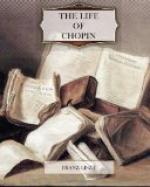Brown and olive-hued Lelia! Dark as Lara, despairing as Manfred, rebellious as Cain, thou hast ranged through the depths of solitude! But thou art more ferocious, more savage, more inconsolable than they, because thou hast never found a man’s heart sufficiently feminine to love thee as they were loved, to pay the homage of a confiding and blind submission to thy virile charms, to offer thee a mute yet ardent devotion, to suffer its obedience to be protected by thy Amazonian force! Woman-hero! Like the Amazons, thou hast been valiant and eager for combats; like them thou hast not feared to expose the exquisite loveliness of thy face to the fierceness of the summer’s sun, or the sharp blasts of winter! Thou hast hardened thy fragile limbs by the endurance of fatigue, thus robbing them of the subtle power of their weakness! Thou hast covered thy palpitating breast with a heavy cuirass, which has pressed and torn it, dyeing its snow in blood;—that gentle woman’s bosom, charming as life, discreet as the grave, which is always adored by man when his heart is permitted to form its sole, its impenetrable buckler!
After having blunted her chisel in polishing this statue, which, by its majesty, its haughty disdain, its look of hopeless anguish, shadowed by the frowning of the pure brows and by the long loose locks shivering with electric life, reminds us of those antique cameos on which we still admire the perfect features, the beautiful yet fatal brow, the haughty smile of the Medusa, whose gaze paralyzed and stopped the pulses of the human heart;—Madame Sand in vain sought another form for the expression of the emotions which tortured her insatiate soul. After having draped this figure with the highest art, accumulating every species of masculine greatness upon it in order to compensate for the highest of all qualities which she repudiated for it, the grandeur of, “utter self-abnegation for love,” which the many-sided poet has placed in the empyrean and called “the Eternal Feminine,” (Das EWIGWEIBLICHE,)—a greatness which is love existing before any of its joys, surviving all its sorrows;—after




